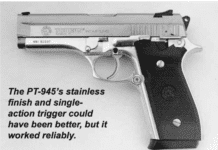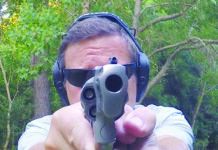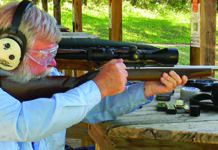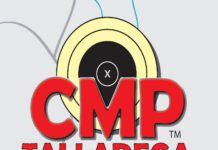Re “Split the Difference: Is a $700 5.7×28
Upper a Good AR Buy?” March 2011
Let me start by asking, why not compare Olympic’s 10mm AR conversion instead of a 5.7×28 upper? When you ask, “Is a $700 5.7×28 Upper a Good AR Buy?”, I think, “Is the 5.7×28 better at anything than a 223 or 22 Hornet?” My own answer is a resounding “Nope!” If I want a small-caliber rifle bullet with lots of speed or penetration, the 223/5.56 seems more than adequate. If I need a smaller caliber than the 223, I can buy a complete 77-22 Hornet for less than the AR upper and feed it less expensive 22 Hornet ammo. The 5.7×28 may be of some value in a handgun, I’ve never found myself in a situation to ponder that question and would speculate that I never will. If I were looking for a personal-defense rifle less powerful than the 223, I think the 10mm is a good start, as I’ve determined that the 9mm makes a fine pocket-pistol caliber but a poor rifle.
Regarding Phil Erickson’s plea to avoid the term “assault rifle,” I don’t have any problem with the term as long as you apply it to the StG 44 and only the StG 44, but I would prefer if you spell it “Sturmgewehr.”
Regards and keep up the good work. —Mark F.
Re “Ruger or S&W Battery Mates: Which Would
You Rather?” March 2011
On page 16, the photo caption states, “The LCR is the first Ruger revolver in our recollection that utilized a detent at the tip of the ejector rod to aid lockup.” The Ruger Security Six, Service Six and Speed Six, manufactured from 1972 to 1988, utilized a detent at the tip of the ejector rod to aid lockup. The Ruger Redhawk, introduced in 1980, was the first Ruger revolver to lock up at the crane. —Charley Heckathorn
As I recall, my first 357 Magnum revolver, a Ruger Security-Six (damn, I miss that gun!), had this feature as did the Speed-Six and Security-Six. I’m sure you or one of your staff remembered this fact just after this edition went to print, right? —Kirk J. Weidler
I guess this one is all on me. A simple search of the www.Gun-Tests.com website turned up a picture of yours truly holding a Ruger Service Six. The Service Six was the fixed-sight version of the Security Six, and sure enough it had a spring detent interacting with the tip of the ejector rod. The article, “Police Turn-in Revolvers; We Test Three Classics Worth the Money,” was published in April 2002. According to a Ruger representative, the Service Six was introduced in 1971. But the www.Ruger.com website lists its introduction in 1972. The website also lists 1988 as the year the Security Six, Service Six, and Speed Six were discontinued. Each of these revolvers featured a spring-loaded detent pin inside the ejector shroud.
—Roger Eckstine
Re: “1911 Range Showdown: Colt Has Heritage,
but Places Third,” February 2011
I’m a long time subscriber to Gun Tests, enjoy the magazine very much, and use the test and rating information when buying new guns. I’m a big fan of the Browning 1911 pistol and own three in 45 ACP and 9x19mm. I’m considering buying another in 45 ACP with target sights, so your comparison test of the Colt, Kimber, and Springfield pistols in the February 2011 issue provided very useful information.
However, I was confused by the conflicting information regarding the rating of the pistols. In the text of the article, the last paragraph reads in part, “All of the pistols gave good service, but in the end the raters agreed that the two top performers were the Eclipse and the Gold Cup. The Colt was the second most accurate pistol… With accuracy as the primary criteria, the Colt carried the day over the Springfield.”
So, the description above clearly puts the Colt in second place, and thus the Springfield in third. However, the title of the article reads, “1911 Range Showdown: Colt Has Heritage, but Places Third,” and the “Gun Tests Report Card Summary” at the end of the article grades the Colt B+ in 3rd place and the Springfield A- in 2nd place.
After stating that the Colt was one of the top two performers, was the second-most accurate pistol, and carried the day over the Springfield, why did it end up in third place? I don’t get it. What’s the rationale for the B+ grade and third place for the Colt? Thank you, and best regards, —Paul Ruffle
I love the magazine, however your assessment of the Colt’s Gold Cup as a B+ I found disturbing. Why did you rate the Springfield 1911 an A-? The Colt was clearly superior in acurracy over the Springfield. It seemed to me that how looks is only of minor importance when shooting targets, you want more accuracy. The Colt was superior and it should have been ranked higher than the Springfield. —Tom Savin
Sirs, the Colt is a fine gun, but the comparison left no room for error, in the opinion of our testers—the other pistols are more likely to serve long and well as an all-round do-anywhere do-anything handgun. The Eclipse and the Springfield each sport very rugged modern adjustable sights. The Colt’s drawback was the old-style sights with the roll-pin attachment to the slide rather than the dovetail. The Eclipse also sported frontstrap checkering, a big plus in a hard-use target-grade handgun. The Colt also was delivered with a bargain basement set of grips we did not like. The Gold Cup was at the top of the heap a generation ago, but no longer. —R. K. Campbell
I see that the Kimber Eclipse was #1 in your three-gun test of 1911s. No surprise. What I noticed was in your largest photo, the the gun shows “Custom Shop” on the left side of the slide and “Custom Eclipse” on the right side. I own two of these guns and neither one of them is marked “Custom.” The only reason mine have ambidextrous safeties is because I purchased them from Kimber. The right-side safety on your large picture has that tab which passes under the right grip panel. Kimber has a safety which has done away with that tab. Then the grip screws, not like the black ones on the smaller photo under the larger photo. So what is the story of a “Custom Shop” Kimber?
Also, I notice the Colt still uses a “drop in” beavertail safety, not like the Kimber or Springfield, which put more work into their guns. It is no wonder that Kimber has taken the 1911 business away from Colt.
—Michael Quintero
Houston, Texas
I saw your test of Kimber’s Eclipse Target II. I was wondering when and where you purchased this pistol from, as the pistol shown in the test says Custom Shop on the slide and has the ambi-safety. Kimber removed the Eclipse line from the custom shop a few years ago, and they no longer say custom shop or come with an ambi-safty as shown on the test pistol in the article.
—Rob Postle
The Kimber in the story was picked up from a local Kimber stocking dealer not that long ago. Kimber’s custom shop guns are a little different than most. I also own a Gold Combat picked up just before the transition from wooden stocks to micarta, and it is marked Custom Shop as well. Kimber tells me that their Custom Shop guns are a result of careful hands-on attention during the assembly process. Certain guns were marked for special attention and handled by specialists on the production line, which differs from the Smith & Wesson or Springfield shop approach. This may or may not be current. Thanks for reading this feature. —rkc
I’m a firearms examiner in Iraq. I have owned lots of 45s over the years, and I enjoyed your recent test of three target 45s. You mentioned that only Kimber had factory-adjustable night sights. I have owned a Les Baer 45 for many years now with the same feature, i.e. factory-adjustable tritium night sights.
—Gordon Rutter
JEFF3 Iraq
Thanks for the information. Perhaps I should have said “ordinary 1911s,” as the Les Baer is by far and away a very, very different type of 1911. Some call it the
ne plus ultra. I honestly was not aware of another adjustable sight handgun with night sights. —rkc
Re “Multi-Use Holsters: Can One Leather
Choice Do Two Jobs?” February 2011
Thanks for another very informative article. I turned to Simply Rugged about a year ago as I searched for a multi-use holster for a 3-inch Charter Arms Bulldog. I chose the Silver Dollar holster with additional inside-the-pants straps as the solution. The holster has been worn in multiple applications on a daily basis during the past year. It works extremely well in cross draw, appendix, and strong-side-carry positions when configured as either an inside- or outside-of-pants holster. It is comfortable and remarkably secure, even without any sort of retaining strap. I also found that Simply Rugged produces a Pocket Protector holster, which was the only pocket holster I was able to locate for the 3-inch Bulldog. In any pants with a suitably deep pocket, the weapon is well concealed, secure and accessible.
I’ll be placing an order with Simply Rugged for another hard-to-locate holster to fit an old S&W Model 39-2 in the near future.
—Mark C
Where did you find one of these holsters for $38?
—Richard Crowson
I found the Classic Old West Styles Four Way Holster at Sportsmans Guide (www.Sportsmans Guide). However, the price has gone up about a buck in the year or so since I obtained mine. The price is almost $40, but the Club Price, whatever that is, is now $35.97. This is a surprising price for this type of holster, I have to admit. One of my cohort who once used a Hersey Four Way noted he liked the COW better, and information keeps coming in. BTW, hot tip: Sportsman Guide illustrates a shoulder holster from the same maker that looks good for just short of fifty bucks. We may have to look at that one! —rkc
Group Measurements, Old and New
Is there a simple way to convert the new accuracy and chronograph data, e.g. average group radius, maximum spread and shot radius to the old accuracy and chronograph data, eg: smallest, largest and average group. I have approximately six binders of old Gun Tests magazines and I compare the data. —Mark G. Gale
Yes, Average Group Radius is comparable to Average Group Size. AGR is more likely to describe how a gun will actually shoot because it contains three to five times more data than AGS. If you want to compare performance between two guns, just that one measurement is enough. —Todd Woodard
Kahr PM9 and Gen4 Glocks
I utilize Gun Tests like I do Consumer Reports: To give me advice/information on objects I plan to purchase because I can’t know everything about everything. Both publications test the short time assessments of a product. However, Consumer Reports will also assess the long-term reliability of products, and I encourage Gun Tests to do the same. Case in point:
The Kahr PM9 was recommended by Gun Tests. I purchased one and ran several hundred rounds through it. After breaking it in and cleaning it, I continued to have feeding problems. Plus, if I put a spare mag in my pocket, I soon found loose rounds in my pocket as well because they would pop out of the magazine.
These problems were explained on YouTube, in the “Kahr PM9 Review – Won’t Rack with Full (Kahr) Magazine” video. The YouTube author suggested using ProMag magazines to fix the problem, but ProMag stopped making PM9 magazines. In short, this fine gun is not reliable, and when I contacted the company, it quickly became clear that they don’t know how to fix the magazines or the feeding problems. Consequently, I got rid of the gun.
Now Glocks also are rated highly in Gun Tests. However, there are many YouTube films showing many feeding problems and fired-brass-in-the-face problems with Gen4 Glocks. I mean, the entire line is toast if you believe reliability is important, much less keeping brass out of your face.
Therefore, please consider not just testing guns, but holding off on your reports for a time period until a staff member has a lot of time and experience with a gun before you publish your opinions.
—Dr. Sam Shaw
Yes, the issue would be when to stop the test of a given gun. Could be years. One of the things I prioritize in Firing Line is complaints about guns we’ve recommended. It is possible for us to miss a dog, but I continue to be amazed at how many dogs we find. It seems that
Gun Tests writers are the only ones who get bad guns. —tw
Re “Gauging 380 ACP Loads: FMJ May Be the
Only Way to Go,” October 2010
Always seeking a best load for my concealed carry 380s, I read your 380 ammo test with interest. With penetration seeming to be the article’s main concern, I see no reason to switch from Buffalo Bore ammo I currently use in my 380 and 32 pocket pistols, but I would like to see you include the brand in a more thorough review of various ammunition available. My tests of four ammo brands in 4×4 lumber shows BB gives 30% to 50% more penetration.
—Stephen Clark




























